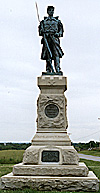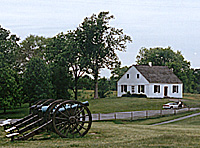The Cornfield
6 a.m. to 9 a.m.
 Hooker unleashed I Corp at 6:00 a.m. into a 40-acre area bounded roughly by a triangle of the North Woods, East Woods, and West Woods. Preceded by an artillery barrage and attacking to the south, the Union troops marched past the Miller Farm and through Miller's Cornfield--at the beginning of the battle filled with tall cornstalks and at the end, leveled by musket and artillery fire.
Hooker unleashed I Corp at 6:00 a.m. into a 40-acre area bounded roughly by a triangle of the North Woods, East Woods, and West Woods. Preceded by an artillery barrage and attacking to the south, the Union troops marched past the Miller Farm and through Miller's Cornfield--at the beginning of the battle filled with tall cornstalks and at the end, leveled by musket and artillery fire.
At right, the Cornfield today, from Confederate positions along the split rail fence (along Cornfield Ave.). The Miller Farmhouse is in the left distance, the North Woods in the far distance. The wheat in the field is approximately 3 feet high.
Large version of panoramic photo (slow: 159K)
At left, the monument to the 124th Pennsylvania Volunteer Infantry Regiment, Colonel Joseph W. Hawley commanding, located just to the west of the Hagerstown Pike. The Cornfield is off picture to the right. The West Woods is off picture to the left. According to the inscriptions, the 124th was recruited in Chester and Delaware counties in August 1862 for nine months service. Casualties at Antietam are: 5 killed, 42 wounded, and 17 missing.
It was at this breaking point, around 7:00, that the Texas Brigade under Confederate General J.B. Hood counterattacked from the West Woods area, driving Hooker's depleted command back through the cornfield. Folklore recounts that the Texans were mad because the Union attack interrupted their breakfast--the first hot meal in days. Whatever the motivation, the Texans chased the Union out of the cornfield, but in the process, overreached. The Union I Corp rallied near the Miller farmhouse, in part due to an artillery battery pouring cannister at 20 yards into the oncoming Texans. Hood fell back in disarray.
At right, a Confederate look from Hagerstown Pike downslope towards the East Woods (in the left distance). The Cornfield off picture to the left. The Mumma Farm is off picture to the right. Sedgewick came from this direction. In 1862, the distance between the Pike and the East Woods was between 400-500 yards. The paved road, Cornfield Ave., is modern.
At left, a view from Sedgewick's position. The Cornfield is beyond the cannon, Hagerstown Pike is off picture to the left, 200-300 yards away.
At right, Dunker Church, with the West Woods beyond. In 1862, the woods started just behind the church--the open field there today was not there. Built in 1853 by German Baptists, the Church withstood the battle, but was destroyed by a wind storm in 1921 and rebuilt in 1962. It measures about 10 yards on a side. Closer Look at Dunker Church (10K).
Sedgewick, however, had a problem. Although his troops drove past Dunker Church (also referred to as Old Dunkard Church), he was isolated and lacking support.
At left, four major types of artillery. From left to right:
1857 12lber "Napoleon" Range: 1600 yards, Approximate number in battle: CSA: 27, USA: 108
10lbr Parrott Rifled Cannon, named for designer Robert parker Parrott. Range: 1900 yards. Approximate number in battle: CSA: 36, USA: 42
3 Inch Ordnance Rifled Cannon. Range: 1800 yards. Approximate number in battle: CSA: 40, USA: 94. The Confederates held the West Woods, the Union held the East Woods and nominally the Cornfield, and the bloody battle over a cornfield drew to a close with both sides exhausted.
It was about this time that Clara Barton became the Angel of the Battlefield.
Antietam
This article appears in MagWeb (Magazine Web) on the Internet World Wide Web. Losing heavily as they pushed through the stalks, the Union troops nonetheless ground ever closer to Dunker Church, sending Jackson's troops backward approximately 1/2 a mile.
Losing heavily as they pushed through the stalks, the Union troops nonetheless ground ever closer to Dunker Church, sending Jackson's troops backward approximately 1/2 a mile.
 At this time, 8:00, XII Corp proceeded to drive through East Woods and attack through the cornfield, dislodging the Confederates once again and forcing them back to the West Woods, where remnants of Jackson's three divisions halted the attack and grimly hung on. Hooker is wounded, Mansfield killed, and the attack stalls by 9:00.
At this time, 8:00, XII Corp proceeded to drive through East Woods and attack through the cornfield, dislodging the Confederates once again and forcing them back to the West Woods, where remnants of Jackson's three divisions halted the attack and grimly hung on. Hooker is wounded, Mansfield killed, and the attack stalls by 9:00.
 The Union II Corp under Sumner entered the fray late, towards 9:00, with one division under John Sedgewick moving round the Roulette Farm and the Mumma Farm. Sedgewick enfiladed the cornfield and speared into the West Woods around the area of Dunker Church.
The Union II Corp under Sumner entered the fray late, towards 9:00, with one division under John Sedgewick moving round the Roulette Farm and the Mumma Farm. Sedgewick enfiladed the cornfield and speared into the West Woods around the area of Dunker Church.
 The other two divisions of Sumner's II Corps, commanded by General William French and General Israel Richardson, veered southwards and could not support Sedgewick, but even this one division of the third Union corp came close to breaking the Confederates.
The other two divisions of Sumner's II Corps, commanded by General William French and General Israel Richardson, veered southwards and could not support Sedgewick, but even this one division of the third Union corp came close to breaking the Confederates.
 Elsewhere on the battlefield, all was relatively quiet, allowing Lee to gather troops from Lafayette McLaws, John Walker, and Jubal Early and catch Sedgewick's exposed division in the flank. In a half hour, Sedgewick lost 2,200 men and the Union was sent reeling back in confusion. Jackson follows up with another counterattack, but is bloodily repulsed.
Elsewhere on the battlefield, all was relatively quiet, allowing Lee to gather troops from Lafayette McLaws, John Walker, and Jubal Early and catch Sedgewick's exposed division in the flank. In a half hour, Sedgewick lost 2,200 men and the Union was sent reeling back in confusion. Jackson follows up with another counterattack, but is bloodily repulsed.
1841 6lber: workhorse of the Mexican-American War, it was obsolete by the ACW. Range: about 1500 yards. Approximate number in battle: CSA: 45, USA: 0
Introduction to Antietam Battlefield
The Campaign
Morning Phase: The Cornfield
Midday Phase: Bloody Lane (Sunken Road)
Afternoon Phase: Burnside's Bridge
Conclusion: Aftermath
Back to List of Battlefields
Back to Travel Master List
Back to MagWeb Master List of Magazines
© Copyright 1997 by Coalition Web, Inc.
Other military history articles and gaming articles are available at http://www.magweb.com